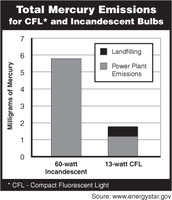CFL Bulb Benefits Outweigh Risks
(Click the image below to view a high-resolution image that can be downloaded)
The question of whether compact fluorescent light (CFL) bulbs are hazardous and should be used in homes has been the subject of some debate.
“Homeowners need to weigh the benefits of using the bulbs over the risks,” advises Carl Pedersen, North Dakota State University Extension Service energy educator.
He believes the benefits outweigh the risks.
Risks
CFL bulbs do contain mercury, and mercury can cause kidney and liver damage when absorbed by the body in high levels. The key term to remember is high levels, Pedersen says. CFL bulbs do not contain high levels of mercury. Also, the mercury in the bulbs must be released by breaking the bulbs for a body to absorb the mercury. If the bulbs are not broken, the mercury is not released into the atmosphere or environment and does not pose a hazard.
Even if all the mercury in a broken CFL bulb were to vaporize immediately, concentrations in an average-sized bedroom still would be below federal recommendations for safe levels of mercury vapor after a short time. Assuming the space where a bulb could be broken is not an air-tight room, natural ventilation would bring the concentrations of mercury vapor to zero fairly quickly, depending on the air exchanges in the room.
Benefits
“Using CFL bulbs actually reduces the amount of mercury in the atmosphere,” Pedersen says.
According to ENERGY STAR, a joint effort of the U.S. Department of Energy and the Environmental Protection Agency, the amount of energy saved by using CFL bulbs reduces the mercury emissions that result from electricity generation. The main source of mercury emissions in the United States is from the production of electricity. By utilizing CFL bulbs, which use up to 75 percent less electricity than incandescent bulbs, you reduce mercury emissions. This is why government agencies, as well as electric utilities, universally have accepted the use of CFL bulbs.
“Almost all homes are full of potentially harmful substances and hazards,” Pedersen says. “Just look under the sink and read some of the warning labels. Household cleaners, pesticides and most all things used in a home can be hazardous if used improperly. But when used according to manufacturers’ recommendations, these products provide benefits.”
The same is true of CFL bulbs, he adds. When used properly, they can save homeowners money while reducing the impact on the environment from lighting sources. CFL bulbs also last significantly longer than incandescent bulbs, reducing the amount of waste that goes into landfills.
“They are not without some drawbacks, but they are the best option presently available, considering cost and ease of use,” Pedersen says.
Cleanup
While the reports of the need to bring in hazardous material teams to clean up a broken CFL bulb have been overexaggerated, you need to handle a CFL bulb carefully if one breaks in your home, according Pedersen.
Here are the steps the Environmental Protection Agency recommends you take:
- First, vent the room for about 15 minutes. If the room has forced-air heating or air conditioning, shut that off.
- Scoop up any glass or powder with a stiff piece of paper or cardboard. Do not use a broom or vacuum on hard floors since it can spread the dust. Place the glass and dust in a sealed container, such as a jar or plastic bag.
- Pick up any additional small pieces of glass or dust with strong tape, such as duct tape.
- The next step is to wipe the area with a damp paper towel or wet cloth and then dispose of all the materials in sealed containers. Place the materials outside and then bring them to the local approved recycling center for CFL bulbs.
- If you break a bulb on a carpeted floor and you need to use a vacuum cleaner, use the same procedure as for removing a broken bulb from uncarpeted floors and then vacuum the carpet after you’ve removed all visible material. After vacuuming, remove the vacuum bag and place it in a sealed container or bag, as you did with the pieces of the light bulb.
For more information on this or other energy-related topics, contact Pedersen at (701) 231-5833 or carl.pedersen@ndsu.edu or visit NDSU’s energy Web site at http://www.ag.ndsu.nodak.edu/abeng/energy.htm.
NDSU Agriculture Communication
| Source: | Carl Pedersen, (701) 231-5833, carl.pedersen@ndsu.edu |
|---|---|
| Editor: | Ellen Crawford, (701) 231-5391, ellen.crawford@ndsu.edu |


